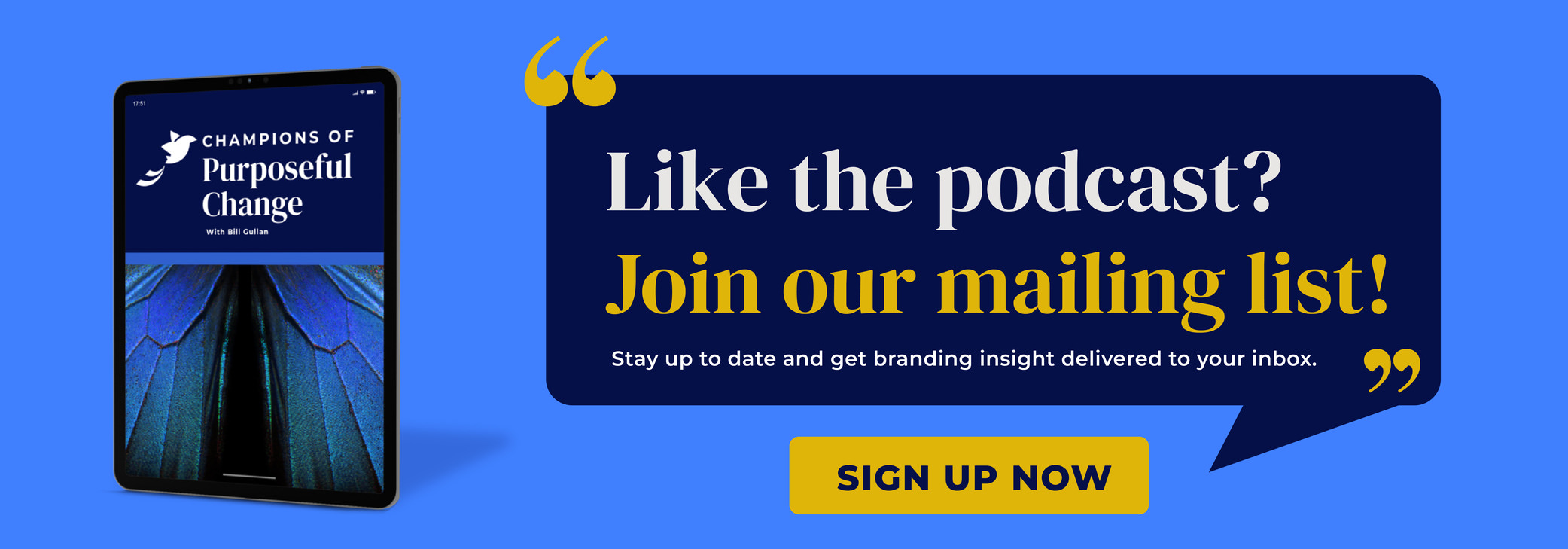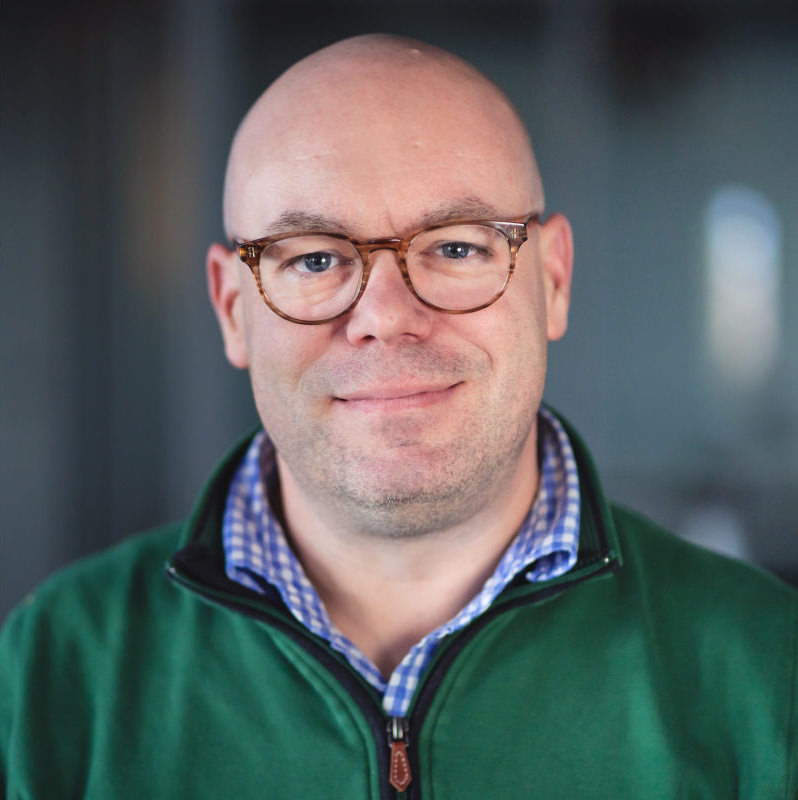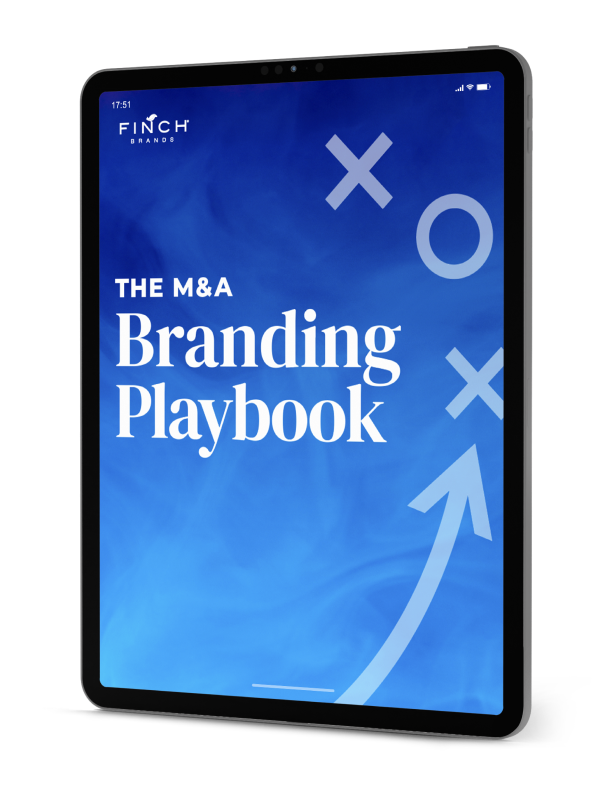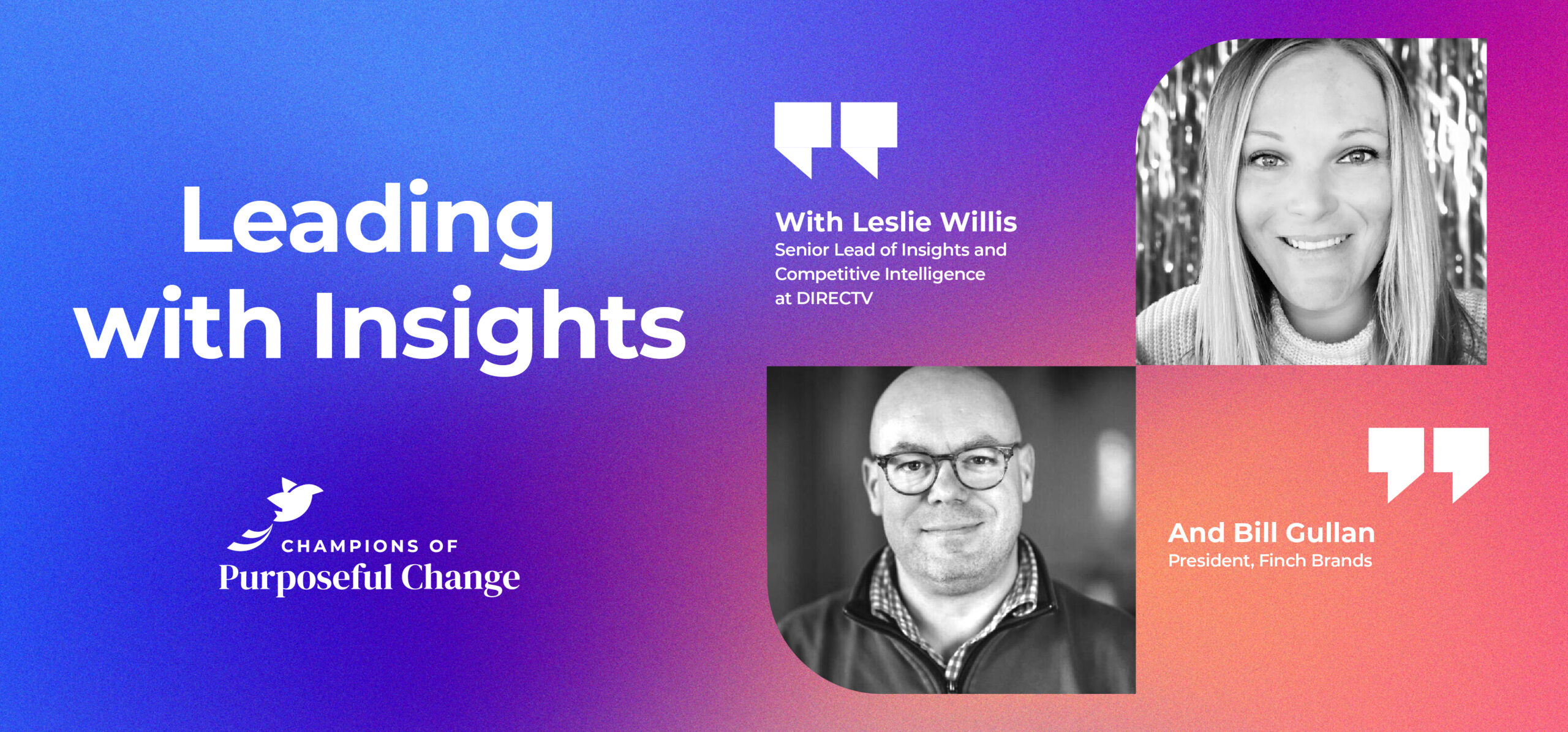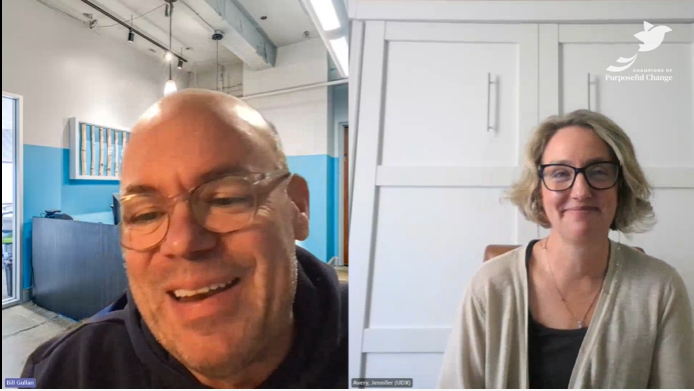A New Take on Sweet – Pete Angevine, Co-Founder of Little Baby’s Ice Cream
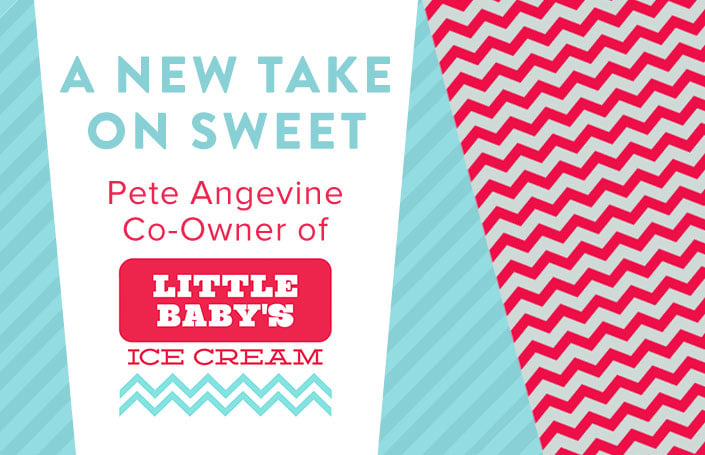
Pete Angevine, Co-Founder and CEO of Little Baby’s Ice Cream, shares his journey and values-driven approach to building an entire business structure, building a brand, and connecting with the consumer. If you like our podcast, please subscribe and leave us a rating!
Podcast: Download Subscribe: iTunes | RSSTranscription:
Pete Angevine: Brand is a lot of what sets us apart. It’s kind of, I think about it like a haircut frequently. We do the same thing as a bunch of other companies, but with a pretty different haircut.
Bill Gullan: Greetings. One and all. This is Real-World Branding. I’m Bill Gullan, President of Finch Brands, a premier boutique branding agency. A real treat today, meant in several ways, as we have Pete Angevine, who is the co-founder and CEO of Little Baby’s Ice Cream here. Certainly, their products are quite a treat. I think what’s particularly notable about this interview, and Pete’s overall approach and point of view and perspective is, it’s very exemplary of a … I wouldn’t even call it a trend, but an increasing shift in the direction of purpose-driven brand creation, and it isn’t just about entrepreneurial purpose. You’ll hear that Pete and his colleagues’ values inform not just the product that they make, and how they make it, but really every business decision.
They have a really well-developed and deeply held set of beliefs around righteous business, and how to execute it in terms of partners, in terms of products, in terms of distribution, and expansion, and this is absolutely a breath of fresh air, so enjoy the thoughts, and the twists and turns, and the beliefs, and the energy of Pete Angevine.
We’re fortunate to have Pete Angevine, co-founder of Little Baby’s Ice Cream, with us here, wearing an awesome sweater. Did not come by tricycle. We’ll hear more about that, but Pete, thanks for joining us.
Pete: Thank you for the invitation.
Bill: It’s our pleasure, and given all that Little Baby’s has done, and just how cool it is, we’re so pleased to get into this story a little bit, and I think those of you in our audience who haven’t heard about this are really going to want to. If we could start maybe there, and talk about your journey, the company’s founding story, and sort of what all this fuss is about.
Pete: Sure. We began Little Baby’s Ice Cream in 2011. It was me and two buddies. None of us had any experience in business or food.
Bill: Music guys, right? Musicians.
Pete: Yeah. We were all musicians, and kind of coming from the various constellations of the music and art world in Philadelphia. Essentially, we all just kind of came to recognize ice cream as a canvas for imagination, and creativity, and just a different way to create an expressive newness for people to enjoy, and hopefully … I guess the idea, too, is that ice cream is a bit more of a unifying thing than esoteric, avant garde music, right?
Bill: Slightly.
Pete: Right. It’s something that brings people together. It makes people happy, and it’s also therefore, I think, a really ideal platform for subversion. It’s an easy way to…
Bill: Yeah, you sneak in there. Nobody’s going to look twice at ice cream, and there’s opportunity to sneak in a counter-culture message, right?
Pete: Yeah, exactly, but it’s frozen milk and sugar, so it’s generally pretty tasty. Yeah, we started in 2011, just as a hobby. Kind of on nights and weekends. I was working personally at the Mural Arts Program at that time, and the beginning and end of our original business plan was to take this one custom-built tricycle that a sculptor friend helped us put together, and we were going to go out to concerts at the First Unitarian Church, and sell funny-flavored ice cream with hot sauce in it to people with purple hair and tattoos.
Very quickly we recognized that there was a much broader audience for what we were doing than just that. That first summer in 2011, was very successful to the point where we had one of those quote unquote ‘good problems,’; where every time we went out, the ice cream was just gone.
Bill: Right. Couldn’t make it fast enough.
Pete: In three hours, yeah, but it took us an entire week to make that amount of ice cream, etc. etc. So we’re kind of chasing our tail for the first year, but we got the message that there was an appetite for unusual-flavored ice cream as well as non-dairy ice cream here in Philadelphia, and that was right at kind of the precipice of this whole mobile food fad. In 2012, 2013, the food truck scene in Philadelphia really kind of exploded, and we were honestly coincidentally just ahead of that, so the timing went great. Then we spent the whole off season of 2011, 2012 raising a bunch of money and figuring out how to really establish ourselves as a proper, non-renegade operation.
Bill: Right. Collared shirts, and right.
Pete: I don’t usually wear a collared shirt.
Bill: You do.
Pete: Today I am. Right, so we had an opportunity that year to take on a proper production facility and small retail outlet on Frankfurt Avenue in East Kensington, Fish Town. It’s attached to a place called Pizza Brain, which is a pizza restaurant and the world’s first and only pizza memorabilia museum.
Bill: That’s right. It’s delicious. Yeah.
Pete: Yeah. It’s good pizza. I have it four to six days a week.
Bill: Probably.
Pete: Yeah, we kind of met them just from around in the neighborhood, and my partner Martin had at one time played music with one of the guys from Pizza Brain, and we knew each other kind of from around the way. We recognized pretty quickly that we were approaching different foods with a similar spirit, and that we could really create a, kind of an absurd, wonderful emporium of what was then sort of in the middle of nowhere on Frankfurt Avenue.
That allowed us to really kind of get our feet on the ground and make a reasonable amount of ice cream with commercial equipment and things like that for the first time. That summer, we also grew our fleet of custom-built tricycles from one to four.
Bill: Nice.
Pete: We worked that summer with a local one-man, year-round cargo trike builder, Haley Trikes, which is actually just up the road on Frankfurt Avenue. Right now, we have a couple different modes of our business. We have four tricycles. They sometimes act as they used to, which is sort of like a food truck at concerts or the big festivals. Primarily though, over the last two or three years, maybe, we’ve been skewing more towards private catering events, so we do lots, and lots, and lots of weddings, and birthday parties, and some corporate events, and things like that.
It’s a lot easier, in certain ways, to do it that way, and it’s also … When we started, we were the only small batch ice cream company dong what we were doing, and now there’s a bunch, which I think is great. It kind of pumps up the ice cream culture for everybody, but it makes those big festivals a pretty different game. We use the trikes for vending and catering. We have our retail shop on Frankfurt Avenue. We have one in West Philadelphia, in the Cedar Park neighborhood.
Bill: There’s the world headquarters and the embassy, right?
Pete: The Cedar Park Embassy. That’s right. Yeah, we opened that in the spring of 2013. Then last Memorial Day, in 2016, I guess we started doing a weekly popup every Sunday at a place called Union Market in Washington, D.C., which has been phenomenal.
Bill: Does that seem random? How’d that come about?
Pete: Yeah. Maybe I’m jumping around in a little bit of a funny way, but we work very closely with our dairy provider, which is called Trickling Springs Creamery. It’s a company based in Chambersburg, PA. We’ve been working with them not quite since day one, but since like day four, let’s say, and in my mind, and in the mind of many others, they are truly icons of sustainable agriculture in Pennsylvania. It’s all grass-fed, all-natural, super premium, 16% butter fat dairy.
Every year, we take our team out to meet the actual cows from where our milk is coming, and they just do an incredible job out there. They’re a large part of the reason that our ice cream is so delicious, and so we’ve kind of over the years added more and more components to our relationship. One of those components now is that they operate a stall at Union Market in Washington, D.C. They are Mennonites. They do not do business on Sundays. We are heathens, and we do.
Bill: Just have to work, right?
Pete: Every Sunday, there is this bustling, vibrant market in the middle of D.C. with thousands and thousands of people in it, and that ice cream stand with the lights off. Trickling Springs is paying rent for when they’re not doing business, so it was kind of a lose-lose-lose for everybody. Now we’ve worked out a pretty simple arrangement, in which we can just pop up there every week. We kind of throw up some curtains, make it look a little Babisian, put our ice cream in their freezers, and it’s Little Baby’s Ice Cream for I think about nine hours every Sunday.
Bill: Yeah. Pack it up and go back.
Pete: We pack it up and go back, and now at this point, we have staff down there, and we’re not required to go every week, which is huge.
Bill: That is huge.
Pete: It’s great. It’s great for them. We’re helping cover their costs. It’s great for us. We have the presence in a very popular ice cream stand once a week, and it’s great for the market and the people at the market, because there’s not an ice cream shop with the lights out.
Bill: That’s great.
Pete: Trickling Springs has got a pretty good presence here in Philadelphia. You’d recognize their grass-fed milk in glass bottles in every Whole Foods, and all the kind of fancier grocery stores around. That’s how most people know them, but down in D.C., and in Baltimore, and in Maryland, they’re like a household name. They’ve got a much larger presence down there, so if they have trucks up in Philadelphia once or twice a week, they have trucks down there four times a week.
That led, in one way or another, to us taking on another opportunity in Baltimore, where we opened just this past December, a few months ago, a stall in a brand-new food hall down there, a neighborhood called Remington. It’s a place called R. House, so it’s this, yeah, beautiful, glistening, brand-new, renovated auto shop, or auto showroom, rather, with a food hall, with I think 12 vendors, and a bar. It’s this really beautiful, bumping place, and we share a tiny little stall with a micro-bakery down there named Crystal. They run a concept called black sugar, and it’s not unlike our relationship with Pizza Brain in some ways, we’re kind of autonomous businesses, but collaborate.
Yeah, it’s like a roommate situation, and because Trickling Springs is kind of running this 95 corridor really regularly, it wasn’t so hard for us to put the pieces together, and kind of ride on their distribution channel and stuff. We aren’t doing things like buying ice cream factories, and fleets of freezer trucks, and things like that, because that’s inefficient and wasteful. Trickling Springs and us, it’s been a real pleasure to work with them because they make a great product, and they’re pretty righteous, honest, hard-working people. But it’s funny, I never thought that I would be so close with a rural, conservative Mennonite.
Bill: Right. Right. It’s a slightly different lifestyle.
Pete: Yeah, whereas we’re these wacky, avant urbanists. We actually share a lot of values about responsible food, and business, and things, so it’s been a real joy to get to work with those folks closer and closer every year. They also help us for the third part of our business. First we talked about the trikes, then the retail shops. The third part is our pints, which we launched about two years ago or so, basically around the mid-Atlantic region, from Princeton to D.C. Trickling Springs-
Bill: Independent stores, primarily what we would call wholesale.
Pete: Yeah, and chains. Chains like Whole Foods and Mom’s Organic Market are picking them up in most of those cities and in between them, and Trickling Springs helps us kind of make and distribute those pints. Our relationship grows every year, and it’s allowing us to expand our business, but do it the way we want to do it, with people we know and trust.
Bill: Mm-hmm. To get all that done in five, six years is quite a story.
Pete: Yeah, with no money at all.
Bill: Yeah, right. To that end, don’t tell me anything that you don’t feel like you should, and obviously this may be something that you guys are kind of … Sounds like you’ve been very opportunistic up to this point. What has Little Baby’s become? You’ve grown physical space, again, via opportunities that in some cases have just come up. You’ve entered the wholesale business, which obviously scales in a meaningful way, but given the supply chain that you outlined, and the importance to you of integrity throughout that, there’s probably some limits to scale, at least geographically. So what are the major things that you’re kind of thinking about at this point as the business progresses?
Pete: We’re definitely kind of hovering around that juncture, I think, of where are we taking this? Are we going to be … Are we trying to become the next Ben and Jerry’s, the biggest ice cream company in America, or are we trying to have a couple neighborhood ice cream shops? I would like to think that there’s a happy middle ground, so in my mind, at this moment, we are trying to … I guess we’re interested in positioning ourselves to be the premiere, super premium ice cream brand in the mid-Atlantic region, so at this point, we have a real presence here in Philadelphia, and have footprints in Baltimore and D.C. Those are footprints that we are very interested in kind of securing and expanding, so right now, we’re looking at a couple of other retail opportunities, and we want to wait and see. What we’re not interested in doing is giving up the integrity of our product, or the quality, or the uniqueness of the flavors, or how we talk about them, right?
We want to remain as, I don’t know what the word is, quirky, or weird, or whatever it is that we are, and also, right. Yeah, I don’t want to get to the point … I would like for it to be a human scaled business. I don’t ever want to have a company where I don’t know personally the people that are working with us. I don’t ever want to have to give up on grass-fed dairy and go to conventional. Right now, I’ve found that small business is a pretty powerful way, or vessel I guess, to live your values, and be the world you want to see, or whatever. Yeah, I’m not really interested in getting to a point where we have to abandon any of that.
Bill: All of this thinking, and sort of these choices and this road lead to ice cream, and you got these creative friends, and you’re going to drive over to events and sell it. The name, the look, the sort of brand creation choices and toolbox that you all employed to create Little Baby’s, could you talk a little bit about that process, and how you all thought through it?
Pete: Sure, so the name. There are a lot of sort of fake origin stories that I’ve created over the years to explain it, but the real truth is that it doesn’t mean anything, and it was never intended to mean anything. Along with ‘stop making sense’ theory, or something like that. Not everything needs to mean something.
Bill: True.
Pete: It’s sort of catchy and memorable, and that felt good enough. Little Baby’s was kind of this phrase that was bouncing around amongst me and a couple friends for a few years before that, so it’s sort of a first thought, best thought, stick with it, go.
Bill: It’s got a little Kerouac-ian sort of feel to me. I don’t know why.
Pete: I’ll take it.
Bill: I don’t know if that’s even a word.
Pete: The other thing that I always think about when people ask me about the name is The Beatles, arguably the greatest band of all time. Their name is spelled B-E-A-T-L-E-S. That’s the stupidest pun ever.
Bill: It’s a very simplistic pun. Right.
Pete: If somebody came up to me now, was like, ‘Hey, I’m in a band called The Beatles. Do you want to … Here’s my CD,’ I would walk away, right? I just take that to mean that it doesn’t matter.
Yeah, right, so it’s Little Baby’s Ice Cream, and then the sort of visual, aesthetic identity is very purposeful, and very particular, I think. I can say that the two main reference points for the brand creation and the look were the set design for Peewee on Broadway.
Peewee’s Playhouse is, in many ways, a pretty inspiring thing for Little Baby’s, yeah, on a bunch of different levels, specifically the show set on Broadway in 2010 was amazing. The set is just incredible, all these clashing patterns, and bright colors, and weird, oblong, stretched out shapes. It’s very much a part of our look now. Then there was also this design movement in the 1980s from Italy called the Memphis Group. People don’t talk about Memphis Group too much, but it’s a very familiar look. Again, just kind of bright colors, and weird shapes, and strong patterns that don’t really sync up with the pattern next to it. They mostly made furniture and a bunch of other stuff, so those were the two real points of departure to create our brand.
Bill: Fascinating, a combination of intent and fancy.
Pete: Mm-hmm.
Bill: Somehow it works.
Pete: Yeah.
Bill: Do you find that the role of the brand in the category here … The distribution methods that you have involve some ability of being present. Obviously the retail, you have the ability to sign it and drive traffic, the sort of delivery either in a stall, or through a trike. You have the ability to be there, and there’s an energetic form of brand delivery there beyond just the wholesale, in the freezer, this one or that one.
Pete: Big time. Big time.
Bill: How do you think about brand, just in general, as you guys seem to cultivate the Little Baby’s story and roll this out?
Pete: How do we … How do I think-
Bill: Is brand recognized by your team as being a really important asset to nurture, or is it … Okay.
Pete: Yeah. Absolutely. Yeah, I think brand is a lot of what we’ve got. I do think that our product is pretty unique in a number of ways. Obviously the majority of flavors we make, they’re endemic to Little Baby’s Ice Cream. There’s nowhere else you can find them. Nobody else makes Earl Gray Sriracha ice cream, for example.
Obviously ice cream is an age-old tradition. There are many, many, many, and more every day small batch, super-premium ice cream companies out there that make really good products, that are strong in other ways, and so the brand is a lot of what sets us apart.
I think about it like a haircut frequently. We do the same thing as a bunch of other companies, but with a pretty different haircut, and that sets us apart. Yeah, the visual identity, the voice, the sound, the kind of immersive experience of the shops. I think that is our main thing in our arsenal. That’s really what we can wield, I think, that maybe others can’t.
There are definitely other people that are more equipped and savvy to handle supply chains, and spreadsheets, and all those kind of nitty gritty business details, but yeah. I think the brand is, it is both unique and odd, and weird, and I think kind of special, but it’s also really kind of an honest expression of things that we like. I think that speaks to people.
Bill: Great. Just moving backwards really quickly, yes, a musician’s past, and that of the founding team were musicians so the story goes, but you also have a degree in urbanism, or urban studies, or whatever. It’s your own sort of personal route to this, and what you always dreamed of being, versus the paths you’ve taken.
Pete: You must’ve Googled me.
Bill: You’re all over the place.
Pete: Yes, I do have a degree in geography and urban studies, which feels kind of funny that this is where I am now, but I do think yeah, indirectly, it absolutely helped shape my worldview, and the way I think about who I am, and how I am in the world. Yeah, for the first, what, 25 years of my life or something, I had a singular focus, an interest in music. That was the only thing I did. That was the only thing I knew how to do. Everybody I knew was a musician. I was on academic probation for three and a half years in high school because I just … I had my priorities, but they were not the same priorities that others had.
Bill: Hey, there’s dignity in academic probation. I will attest to that. Yes.
Pete: Right. I was very, very focused and serious about music, and I ended up going to … I was a jazz performance major at Temple for two years.
Bill: What do you play? What instrument?
Pete: Drums.
Bill: Drums?
Pete: It’s been kind of a very long time at this point.
Bill: Art Blakey?
Pete: I was more of an Elvin Jones.
Bill: Yes. Similar.
Pete: John Coltrain is my hero.
Bill: With the smoke coming out of his head, playing … Yeah.
Pete: That’s my guy.
Bill: Once Elvin got out of the clank, he was amazing or whatever, but the early Coltrain Quartet in, what, ’50, ’60, ’61, yeah.
Pete: Yeah. ’61 and beyond is, I’m into the Cosmic Music.
Bill: Okay. Another Philadelphian?
Pete: Yeah. Absolutely. That was probably the highlight, actually, of my time at Temple, is I got to meet and play with…
Bill: Oh, that’s awesome.
Pete: Yeah, that was a 19-year-old’s dream come true.
Bill: Super cool. Super cool.
Pete: Yeah, that was cool. Right, so after two years of doing that with the help of my closest advisor and mentor and drum teacher, Eric Johnson, I realized that that whole pursuit was a bit ridiculous, and I needed to leave music college, and not study music in a room with no windows, and actually go play music.
I spent the next five or so years on tour with a bunch of different groups and artists. Yeah, I got to see a lot of the world. I got to meet a lot of my heroes. I got to, yeah, play all types of music. Made very little money. It was great, until basically one day in a van in Chicago, I had a 24-year-old existential crisis, and realized that I hated what I was doing, and I was miserable. I was very unhappy, and I wasn’t actually doing something I really cared about. I was just doing what I thought I cared about, because that had been my … I remember being like four years old and telling my parents that I was going to be a traveling musician when I grew up.
I was also, right, I guess that was the culmination of this feeling of not being able to reconcile my day-to-day life of sitting in a van all day, and then going to some smelly club, and waiting around, and all that. I couldn’t really reconcile that with concerns about whatever it is, social justice, and contributing something meaningful and positive to the world around me. Yeah, I had this crashing revelation one night, and it was just like, I can’t do this anymore. I kind of came back home, and was very disoriented, very depressed. I really didn’t know what I was supposed to be doing, and don’t know exactly how I put it together, but one of the things that I remember really enjoying about going on tour was each day being in a new place, different city. I would just take these kind of epic spirit quests by myself, and just walk around, and I kind of realized that I was really interested in city.
Bill: Find the ice cream in every city that you went to.
Pete: I did a fair amount of that. That was before I was really … At that point, I was super obsessed with barbecue, not ice cream.
Bill: Oh, hey. A bunch of that, either one.
Pete: I had a bunch of custom airbrush BBQ t-shirts and stuff. It was a weird phase.
Right, so I became really interested in cities, and I was spending hours a day staring at the trucker atlas in the van and stuff, and I was into the maps. I ended up, a couple months later, basically going back to Temple to study geography and urban studies, which is a department there. Yeah, I think just broadly speaking, that really informed a lot about, yeah, how things work, and how I think things should work, and how people live in cities, and how cities are these evolving, changing, living, breathing, things, and what can I do as a somewhat creative person with a heart to make my city, Philadelphia, which I care about greatly, more interesting and more special or something. Yeah, I did that. Then there this whole other sidebar where I had a catastrophic health incident that put me out for a while, and it’s still an issue in my life. I had a liver transplant. Just came out of nowhere, and it’s still unexplained.
Bill: That’s not unserious.
Pete: Right. Yeah, no. I was on my deathbed as a 24-year-old, but anyhow, I kind of… I still am bouncing back, but I bounced back enough from that to be able to go back to school.
Bill: You look well.
Pete: I take a tremendous amount of medication. Yeah, then I graduated school just in time for the big financial crisis, and …
Bill: Way to go.
Pete: … I couldn’t really find a job, and so ultimately had to make my own job, really is what happened. That just happened to be ice cream, because I loved ice cream. As I mentioned, I kind of was starting to recognize it as this blank canvas, a platform to be creative. Everybody I knew was in a band. Nobody I knew had an ice cream company.
Bill: That’s true. Right. Right.
Pete: Also, right, because of my study of urbanism, I guess, we were exclusively on a tricycle, which is a profoundly mobile, nimble thing. We could just randomly pop up in all these places, and I was also really at that time inspired by the whole, the … What is that art movement called, with the spectacle, the society of the spectacle? Situationism. I was really interested in that, and I was like, wow. What a cool way to create a spectacle, with just goofy flavored ice cream that is actually really delicious, Everything kind of tumbled together from there. That was my back story to it.
Bill: Right. I’m sure all of your colleagues have equally sort of intriguing, and quick-sodic …
Pete: Yeah, exactly.
Bill: Though ultimately successful, at least to this point, paths and stories.
Pete: Yeah. I’m still trying to really figure out how the heck I ended up as a-
Bill: That’s a lot more fun than well, I came through work. I was looking at market inefficiencies.
Pete: Right. I see now that there could’ve been some, yeah, going to business school could’ve been useful in some regards.
Bill: The hell with it. You vaulted over that step, or you’re in the middle of it now, but-
Pete: Yeah, but I do think that what we didn’t know while starting was a huge advantage. I think if we had gone to business school and whatever like that, we wouldn’t have done what we did, because it was pretty improbable. We sort of willed it into being.
Bill: Right, well to that end, you talk about craft and small batch. We’ve certainly seen the impact of that general value system, and line of thinking, and mode of production have a big impact across a ton of categories, certainly in beer, and spirits now, and other things. Not just boozy things, but other things. First of all, to what do you sort of attribute the velocity and currency of kind of a small batch or craft line of thinking, and secondly, why has it translated so well for you guys to ice cream, in your opinion?
Pete: Again, just speaking for myself, I think it is maybe a little bit of a reaction to what’s happened over the last couple of decades or generates, where everything has just conglomerated, and merged, and just these massive multinational corporate brands are just making the cheapest products they possibly can, with no concern whatsoever for the welfare of the environment, or the people that work with them, right?
We just kind of live in this late-stage doomsday capitalist nightmare zone, and the food sucks. Yeah, so on a top level, I feel like it’s a reaction to that, and it’s really just kind of bringing back things to the way they used to be, where people are. Also I think the monoculture is the result of that, everywhere you go is just the same. It leads to a really kind of drab and boring life, and that was a lot of what I saw on tour, too, which was pretty scary. No matter where you are, there’s the Subway and Taco Bell.
Bill: Not sure which city we are in again? Right.
Pete: Yeah, I don’t think ice cream, in my mind, is any different from any other field or industry that’s seeing that type of trend. For my money, I want to support people that either I know, or I could imagine knowing. People with a face, rather than Nestle or whatever. Keeping our money in our local communities and local economies I think is a very real, relevant, smart thing to do. I think a lot more people do care about what’s in their food, and how it was made, and where the raw ingredients come from. You can be a lot more certain of that when you’re dealing with more local or regional producers. Yeah, and the quality’s better. For that, it just, it totally aligns with just the way I see the world in any number of ways, right? Food is just, it’s part of the system.
Bill: Yeah, so to that end, speaking also about sort of the way folks are thinking today, obviously there’s a lot that’s made. You’re kind of leaning into, again, maybe not intentionally, into some trends, and tilting into the wind in the face of others. We talked about Whole Foods, and Mom’s Organic Market, and just the sort of cult cleanliness of this supply chain and everything else is obviously very much of the moment. That said, we have a complicated societal relationship with indulgence at this point. There’s a lot of thinking around ways to, and approaches to, health and wellness, and just look at us visually. There’s still a lot of work to be done, certainly in my case, but how do you, or do you think about just the role of indulgence? Your ice cream, at least in my life, is not just a dessert, but you’re in a sweet category here that some people are doing their darndest at least to avoid day in, day out. Special occasions, certainly, but how do you see the consumer mindset today when it comes to just dessert, indulgence, sweet things, things that are caloric? What’s your take?
Pete: Sure. Yeah. That’s a very fair question, and a real … Right. Because we have such a real attention and focus on sustainably sourcing our ingredients, and using exclusively grass-fed dairy, and because 40% of our menu is made out of coconut cream and is entirely vegan, things like that, we frequently kind of get lumped into this health food category, which I think is funny, and just incorrect, because right. There’s a high amount of fat in our ice cream, and I would never try to claim that it’s good for anyone, or anything like that. We got invited to a lot of these health and wellness festivals, and I don’t want to be patronizing, but I’m always like, I don’t really feel like we belong here.
Bill: Could be very small servings. That’s right.
Pete: One way that I do think we kind of acknowledge our place in that world is that our portion sizes are pretty reasonable. We’re not one of those ice cream companies where you get a softball-type scoop. Granted, that’s a lot because of just the quality, or the qualities of the product. Usually, when you get those really huge ice cream servings, it’s a very low butter fat content, and it’s usually mostly air that you’re buying. We have a pretty low overrun, so there’s not a ton of air, and it’s fairly dense, and that’s also because of all the butter fat. Yeah. Too much of anything is bad, but a little bit of a bunch of stuff is okay, right?
Bill: Sure. I think. Yeah.
Pete: I don’t have any kind of really explicit or rigorous diet, but I don’t eat that much meat. I eat mostly real foods that I can buy from my neighborhood. A lot of it is grown in very close. It’s not like I … How do I say it. Yeah, I think it’s all part of a whole, big, balanced diet. What our ice cream is made from is really the natural byproduct of a millennia’s old project of agriculture that humans, and the earth, and cows have been working on together, as my dairy farmer friend Jeff puts it. It’s like there’s a whole cosmic history to dairy agriculture. I don’t feel that bad about it, but I also feel like the way I am approaching this all is that obviously yes, I’m selling ice cream, which is a pretty indulgent, high-fatty food. If you have tons of it, it’s not super good for you, but the way I really approach my job every day is that I’m more selling an experience, and yeah, something new.
Bill: You said earlier the emotional properties drew you to it, the unifying, the fact that you can’t be eating ice cream and not have a smile on your face. You can’t.
Pete: Right. It’s the universal equalizer. Here, here.
Bill: To that end, the path that you’ve taken here is a fascinating one, and you’ve talked about not only obviously from 2011 on, in terms of what Little Baby’s has become, but your own personal path. Are there any understanding that in some ways this was nonlinear? Any words of wisdom for our listeners?
I think a portion of our listener base here are either students, or they’re starting out, or they’re starting over in their career, and I think they’re hopefully enjoying the fact that we’re bringing brand builders and business people from a variety of different categories, and perspectives, who have really interesting stories to tell, and you’re a great example of this.
Have you, either as you were living it, or as you look back on the choices that you’ve made leading up to this point, come up with any words of wisdom that are kind of important to who you are as a human? We’ve talked about the value system, but as a businessperson, is there anything that you might want to share with somebody who’s at that point of sort of examination of self, and universe, and trying to decide what to do with their lives?
Pete: Yeah. I do think it’s really important that if you’re trying to start some kind of small business, or some kind of venture, it’s really important that your business practice is aligned with the way you see the world, and the things that are important to you. If those conflict at all … I just imagine there would be a lot of 1, you’re probably not doing what’s right for the greater good or something, and two, I imagine that would create some inner turmoil that would be unpleasant, and probably hold you back in some kind of way.
I’m not sure what to say about my really super practical business advice or something that I feel like I learned the hard way from experiences. Something super boring, like make sure you’re fully capitalized, right? Make sure you actually have enough money to accomplish what you’re doing before you do it. We didn’t, and it was incredibly difficult, and it frankly still is at times. On the other hand, if I really understood that in 2011, I probably wouldn’t have done this.
My entire life would be different, and whatever Little Baby’s has been able to offer to the world wouldn’t exist, and yeah. Who knows where I would be? I do think that there is some value in just kind of holding your head up, and walking through the fire, and figuring it out as you go along. Right. I don’t know what advice to give in that regard.
Bill: Yeah. I think you are … How strongly you and others who are sort of a new generation of business builders, certainly in this region, embody this notion of values-driven.
Pete: I think that’s really important, because I don’t … Yeah, I don’t want to come at anybody here or anything but I do frankly think that the generations before us left us with a pretty rough road ahead, and a set of conditions that are not ideal, because they invented some concept that business is a standalone thing that doesn’t actually impact the whole world, and people in their everyday lives. I think that’s just false, and incredibly dangerous, and I think it is incumbent on us as young people to have a different value system that we actually live every day, and business, as I’ve mentioned, is an incredibly powerful tool to do that.
Bill: Right. In some ways what you’re talking about is a modern outlook. In some ways, it’s very much a throwback it seems, particularly in the neighborhood where you all are focused and where you’ve been. There used to be a manufacturing center, and …
Pete: The workshop of the worlds.
Bill: Yeah, it was. That’s Philly, right? We’re here for the making, or whatever they say now. There’s a lot of that happening. So proud to see it, and get to know people who are part of it, but yeah, it’s a new way of an old way of thinking.
Pete: Right. Yeah. I think it’s a beautiful thing that people make things with their hands, and it’s a service to the people around them that appreciate it.
Bill: I choose to eat things with my hands primarily.
Pete: Yeah. Word. With ice cream, you can’t really do that.
Bill: Before we let you go … We’ve kept you longer than we said we would, so this has been great, and thank you so much, Pete for coming, and sharing this story with us, as well as obviously thank you for bringing into existence the products that you have, because that’s a source of joy, and …
Pete: Yeah, sorry I didn’t bring any products.
Bill: I was going to say.
Pete: I could’ve invented freezer pockets.
Bill: Right. You didn’t take the trike over, either. You told us. One of the things about jazz, never certainly to the level of being a type of practitioner that you were, but as a listener, the balance between kind of structure and improvisation is presumably, your sort of level of accomplishment. You could’ve taken your musical desire in a bunch of different directions. Is there a common thread here that your choice of jazz as a source of personal passion may reflect something about you? What was it about jazz that you fell in love with?
Pete: I was always, and this is I think one of the reasons why four years of jazz college didn’t work out for me. I was always pretty, or I am still pretty drawn to the out stuff, as they would say, the late era John Coltrain, right, when he kind of just went into the stratosphere.
Bill: Unlistenable, in my opinion.
Pete: Right. That’s what most people think.
Bill: No shot, right.
Pete: Oh, my goodness. That’s like my favorite thing in the world.
Bill: See, this is why we can be in the same room, but on a different side of the table.
Pete: Yeah, so that is more of the angle of the jazz continuum that I’m really inspired by and interested in. Yeah, love all the other music as well, but yeah. Just that kind of fearless, intrepid, relentless pursuit of something abstract, and beautiful, and powerful, and I think yeah, that’s what I’m really motivated by and inspired by. Just, yeah, John Coltrain was just using his horn in this alienating, violent way, but all it was for him was a path to peace and transcendence.
Bill: Sure. Very personal. Yeah.
Pete: Yeah, and I am not comparing myself to John Coltrain, but …
Bill: I see a lot of similarities. Sorry.
Pete: … Can ice cream be used for that purpose?
Bill: There’s the tao of ice cream here.
Pete: Yeah. That’s sort of how I feel about it. Unfortunately, there’s a lot of business that gets in the way of that, like spreadsheets, and supply chains, and distribution.
Bill: More like crap, yeah.
Pete: Yeah. You got to deal with that along the way, but what can this build towards? Hopefully it’s something kind of transcendent and sublime, and brings inner piece to people. I’ve never really put it in those words, but yeah, that’s my goal.
Bill: Why don’t we leave it there.
Pete: Cool.
Bill: Great place to leave it. Thank you so much for your time and insight. What a story. For those in this region, and certainly down in the District of Columbia, and it sounds like in Baltimore, and in a freezer near you, if you’re choosing your stores wisely, you’re going to be encountering Little Baby’s incredible assortment of flavors, and the great story that is still unfolding. Thanks for your time, Pete. Thanks for joining us.
Pete: Thanks so much for having me.
Bill: Our thanks to Pete. Though disappointed that he didn’t drive over on the tricycle with great flavors in tow, we certainly understand. Pete and the team at Little Baby’s really are a profound example of not only sort of an entrepreneurial spirit, but a values-driven approach to building an entire business structure, building a brand, connecting with the consumer, and they’re certainly one to watch, so thank you, Pete.
As always, three ways to support what we’re doing here at Real-World Branding, and I know that we haven’t been as consistent in terms of offering these up new as we hope to be, and our hope is to get back to it, but three ways. We love the dialogue that we have with our listeners on Twitter, @billgullan or @finchbrands, ideas for future guests, comments on what we’re doing well or not so well, as well as just general thoughts on the overall state of business and brand development. We’re grateful for the contribution and really actively interested in continuing this dialogue.
As always, other ways to help make sure that this content becomes known to folks who would find value in it is to subscribe through the app store of your choice, and then if we deserve it, pop us a little rating in there. Hopefully four or five stars, but either way, it lets us know that folks are out there consuming this, and again, hopefully finding both practical and inspirational value. We’ll sign off, from the Cradle of Liberty.
